#ocr scanning
Explore tagged Tumblr posts
Text
This scan of the Ganguli translation of the Mahabharata can't load in Archive.org's in-browser viewer. It's more than 8GB.
#i assume the goal of a huge high-quality scan is to allow someone with the computing power to spare to use it for LLM-assisted OCR to ka#but maybe you should have split it up by book buddy#this is really high in most search engines' results for 'ganguli mahabharata' there's normal people navigating to it#mahabharata
9 notes
·
View notes
Text
[gritting my fucking teeth] on a better note. i'm finding lots of reasons to learn python lately. i've wanted to learn more python for a while, but didn't really have any project ideas that were motivating enough to me to actually pursue beyond basics. but recently! various shit i want to automate and etc.
#doing a lot of preliminary reading on ocr and pytessaract for some really neat scans of old books and documents i've found recently#and it's kind of leading to a lot of other stuff adjacent to language stuff#honestly i'm just having a nice time :)#accidentally getting into nlp lmao#prattling about the self
5 notes
·
View notes
Note
I'm curious about Declan and:
Gil
Tatya
Bo
Horatio
Asking you to write a whole essay lmao
Send me a platonic pairing and get an essay lol
genuinely thank you Kendrick I want to write you an essay lol (and honestly good excuse for more dynamic building)
Declan & Gil
Declan is happy that Tristan has someone else in her life telling her to stop blaming herself for Cady's death, because even though she introduced him to warp racing everyone knows Cady did whatever he damn well felt like and no one can hold her (the person who also got out of warp racing and told Cady to) accountable for his actions. He also likes listening to Gil's tales of school shenanigans and explanations of her craft projects. He feels like she actually listens when he talks, and that means a lot. But he's never fully gotten over the feeling of envy that Tristan gets to have a partner while he remains in permanent mourning. He tries not to let it color his relationship with Gil. But on some level Gil knows that's what he thinks and she can't really blame him. She actually knows a lot more about Declan in general than he knows about her, not because he's not interested in her life but because she's good friends with Rodney, and Rodney always ends up eventually talking about Declan. She also knows things that Declan doesn't (or at least doesn't discover until Nicea), like that Rodney has been secretly borrowing Declan's storage unit keys to check up on things. She won't say this to anyone except Tristan but she wishes there was more she could do for him beyond occasional gifts and distractions.
Declan & Tatya
I harp on how Tatya is a lover and a flirt and oupy but she is also a genuine professional, and when she's around Declan (read: the boss) she gets right to the point and is very clear about what she can and can't do. Declan loves this, and also loves the absolute smoothness of her warps. Like, professional warp witches who work out of contracting companies do good warps, but never with the same almost-imperceptible entry and exit Tatya can manage. Declan is, however, kind of over the conflict between her and Isabel. It seems to be mostly ribbing, and they keep it out of his bridge, but oh boy does he not want to have to lay down the law about them shutting up, so he hopes it doesn't become anything beyond that. For the most part Declan just doesn't think about Tatya outside of her doing her job or hanging out in the bridge - even though she's constantly in the Nicea instead of her own attached ship she hasn't been incorporated into the flow of the crew in his opinion - but he is vaguely fond of her presence, maybe because she reminds him a little of Cady. Tatya mostly just wants to impress him, because she wants to do well and get paid, but also it's obvious to her that he's in charge of this weird quasi-family dynamic and if he's cool with her, then Isabel has to actually face her requests instead of complaining to this guy about it (if anyone actually complains to this guy. she's beginning to doubt that he even accepts complaints).
Declan & Bo
To be perfectly honest Declan doesn't get Bo. No one really does except Tristan but Declan is especially ??? when it comes to them. On the plus side, Bo is usually pretty quiet and doesn't try to draw Declan into shenanigans. On the minus side, they're always saying weird shit and getting everyone around them to be loud and eating everything (that can be a plus too. depends on whether they're eating the things he wanted). Because Bo is very pro-warp racing, Declan has always been kind of suspicious of them, but Cady always came back in one piece, so… He doesn't blame Bo for Cady's death exactly, but he also very much does not not blame them for it. Without easy access to a warp witch even Cady's thrill-seeking ass would not be out there warp racing so much, but also without that witch being Bo that might have been a more dangerous prospect. Perhaps the best description of their relationship is that Declan tolerates Bo, in the most neutral way possible, and Bo thinks that Declan is a real solid guy. Nothing like Cady, and probably doesn't even like them, but still solid. And also sometimes points them to the food in his fridge he doesn't want, which they are happy to take care of. After spending a decade with Cady Bo has a lot more understanding of Declan, but I'm not sure how much that comes out in their interactions.
Declan & Horatio
Declan has an immense respect for Horatio based 50% on Horatio's meticulously-kept records. I realized because of this ask that if Nicea and AOM take place at roughly the same time (as I assumed) and Cady picked up the old dashboard corona from Horatio a little over ten years ago, this means that Horatio has been running a little side hustle in plant sales since he was in college, which honestly checks out. But I think that also means that Declan has never seen Horatio's shop before Nicea, because that definitely didn't exist a decade ago. Still, Horatio has always kept handwritten sales records in an extremely neat and readable print hand (Declan can't fathom this. how can you write that much print, with a pen, no less) and Declan is extremely enchanted by this. The other 50% of Declan's respect comes from the fact that Horatio was the one who decorated Cady's funeral (in this culture, more a party/celebration of life than a funeral, and divorced from the actual burial) and never once made a fuss to him about anything or turned his customer-service cheerfulness on him. There was simply a moment as Horatio was packing up everything where, unprompted, Horatio cut him an orchid to put on Cady's grave, and explained that it was a Summer Band symbol of grief. Horatio, for his part, has no idea what it feels like to lose someone like Declan has - multiple times! - but he figures that's a good reason to just stay out of it.
Nicea taglist: @kahvilahuhut @kk7-rbs @outpost51 @writernopal @athenswrites
#Tatya trades quality of warp for length of warp tbh#Horatio has very nice handwriting. but he's kept it nice partly for reasons of being able to OCR scans of his paper records#he's really an It Guy but like. specifically in the fact that he has his ambitions So Handled#c: Declan#c: Tatya#c: Gil#c: Horatio#c: Bo#ship names tag game#wip: nicea
5 notes
·
View notes
Text
slowly picking away at some more artwork and also item renders i scanned from the game guides. those might get finished next weekend since i've got a lot of things going on this weekend :0
#studio ramblings //#gotta move all my shit back and also clean#and also start scanning the ffcc light novel so i can ocr it#also gotta ocr the entirety of memories like the sunshine for archival purposes as well
0 notes
Text
actually my mom has a subscription to southern living and we scan a lot of the recipes from it to keep them on the computer. . . . wondering if i could use ocr to put them in notion somehow instead of keeping them all saved as image files i think my parents would appreciate that
#pers#i'm sure i could transcribe them by hand but no offense i would rather play in traffic#just scanning them in took forever i would greatly prefer to use ocr
1 note
·
View note
Text
https://www.tvwriting.co.uk/tv_scripts/Collections/Drama/Supernatural/Supernatural_15x18_-_Despair.pdf
NOW you are prepared.

[Image ID: A screenshot of three folders which have been labeled 'memes if Donald Trump wins', 'memes if Georgia turns blue again' and 'memes if Kamala Harris wins' respectively. /End ID]
I am prepared.
#tv writing is where we found our first scripts#only felt right to send pdfs over whenever we got new ones#he usually adds the latest draft and usually one per episode#the scan of 7x17 was too low quality for ocr to work so that's why it's not there#anyway#destiel#remember remember the fifth of november#supernatural
14K notes
·
View notes
Text
Simplifying OCR Data Collection: A Comprehensive Guide -
Globose Technology Solutions, we are committed to providing state-of-the-art OCR solutions to meet the specific needs of our customers. Contact us today to learn more about how OCR can transform your data collection workflow.
#OCR data collection#Optical Character Recognition (OCR)#Data Extraction#Document Digitization#Text Recognition#Automated Data Entry#Data Capture#OCR Technology#Document Processing#Image to Text Conversion#Data Accuracy#Text Analytics#Invoice Processing#Form Recognition#Natural Language Processing (NLP)#Data Management#Document Scanning#Data Automation#Data Quality#Compliance Reporting#Business Efficiency#data collection#data collection company
0 notes
Text

Efficient OCR Paper Scanning Services for Digitizing Your Documents
Digitize your paper documents with our efficient OCR paper scanning services. Our expert team uses Optical Character Recognition (OCR) technology to convert printed documents into searchable and editable digital files. Enhance document accessibility, searchability, and storage with our professional OCR paper scanning services. Contact us for reliable document digitization solutions. https://www.dataplusvalue.com/ocr-scanning.html
0 notes
Text
#Document Digitization#Paper-to-Digital Conversion#Scanning App#Digital Archiving#OCR (Optical Character Recognition)
0 notes
Text
AI’s “human in the loop” isn’t

I'll be in TUCSON, AZ from November 8-10: I'm the GUEST OF HONOR at the TUSCON SCIENCE FICTION CONVENTION.

AI's ability to make – or assist with – important decisions is fraught: on the one hand, AI can often classify things very well, at a speed and scale that outstrips the ability of any reasonably resourced group of humans. On the other hand, AI is sometimes very wrong, in ways that can be terribly harmful.
Bureaucracies and the AI pitchmen who hope to sell them algorithms are very excited about the cost-savings they could realize if algorithms could be turned loose on thorny, labor-intensive processes. Some of these are relatively low-stakes and make for an easy call: Brewster Kahle recently told me about the Internet Archive's project to scan a ton of journals on microfiche they bought as a library discard. It's pretty easy to have a high-res scanner auto-detect the positions of each page on the fiche and to run the text through OCR, but a human would still need to go through all those pages, marking the first and last page of each journal and identifying the table of contents and indexing it to the scanned pages. This is something AI apparently does very well, and instead of scrolling through endless pages, the Archive's human operator now just checks whether the first/last/index pages the AI identified are the right ones. A project that could have taken years is being tackled with never-seen swiftness.
The operator checking those fiche indices is something AI people like to call a "human in the loop" – a human operator who assesses each judgment made by the AI and overrides it should the AI have made a mistake. "Humans in the loop" present a tantalizing solution to algorithmic misfires, bias, and unexpected errors, and so "we'll put a human in the loop" is the cure-all response to any objection to putting an imperfect AI in charge of a high-stakes application.
But it's not just AIs that are imperfect. Humans are wildly imperfect, and one thing they turn out to be very bad at is supervising AIs. In a 2022 paper for Computer Law & Security Review, the mathematician and public policy expert Ben Green investigates the empirical limits on human oversight of algorithms:
https://papers.ssrn.com/sol3/papers.cfm?abstract_id=3921216
Green situates public sector algorithms as the latest salvo in an age-old battle in public enforcement. Bureaucracies have two conflicting, irreconcilable imperatives: on the one hand, they want to be fair, and treat everyone the same. On the other hand, they want to exercise discretion, and take account of individual circumstances when administering justice. There's no way to do both of these things at the same time, obviously.
But algorithmic decision tools, overseen by humans, seem to hold out the possibility of doing the impossible and having both objective fairness and subjective discretion. Because it is grounded in computable mathematics, an algorithm is said to be "objective": given two equivalent reports of a parent who may be neglectful, the algorithm will make the same recommendation as to whether to take their children away. But because those recommendations are then reviewed by a human in the loop, there's a chance to take account of special circumstances that the algorithm missed. Finally, a cake that can be both had, and eaten!
For the paper, Green reviewed a long list of policies – local, national, and supra-national – for putting humans in the loop and found several common ways of mandating human oversight of AI.
First, policies specify that algorithms must have human oversight. Many jurisdictions set out long lists of decisions that must be reviewed by human beings, banning "fire and forget" systems that chug along in the background, blithely making consequential decisions without anyone ever reviewing them.
Second, policies specify that humans can exercise discretion when they override the AI. They aren't just there to catch instances in which the AI misinterprets a rule, but rather to apply human judgment to the rules' applications.
Next, policies require human oversight to be "meaningful" – to be more than a rubber stamp. For high-stakes decisions, a human has to do a thorough review of the AI's inputs and output before greenlighting it.
Finally, policies specify that humans can override the AI. This is key: we've all encountered instances in which "computer says no" and the hapless person operating the computer just shrugs their shoulders apologetically. Nothing I can do, sorry!
All of this sounds good, but unfortunately, it doesn't work. The question of how humans in the loop actually behave has been thoroughly studied, published in peer-reviewed, reputable journals, and replicated by other researchers. The measures for using humans to prevent algorithmic harms represent theories, and those theories are testable, and they have been tested, and they are wrong.
For example, people (including experts) are highly susceptible to "automation bias." They defer to automated systems, even when those systems produce outputs that conflict with their own expert experience and knowledge. A study of London cops found that they "overwhelmingly overestimated the credibility" of facial recognition and assessed its accuracy at 300% better than its actual performance.
Experts who are put in charge of overseeing an automated system get out of practice, because they no longer engage in the routine steps that lead up to the conclusion. Presented with conclusions, rather than problems to solve, experts lose the facility and familiarity with how all the factors that need to be weighed to produce a conclusion fit together. Far from being the easiest step of coming to a decision, reviewing the final step of that decision without doing the underlying work can be much harder to do reliably.
Worse: when algorithms are made "transparent" by presenting their chain of reasoning to expert reviewers, those reviewers become more deferential to the algorithm's conclusion, not less – after all, now the expert has to review not just one final conclusion, but several sub-conclusions.
Even worse: when humans do exercise discretion to override an algorithm, it's often to inject the very bias that the algorithm is there to prevent. Sure, the algorithm might give the same recommendation about two similar parents who are facing having their children taken away, but the judge who reviews the recommendations is more likely to override it for a white parent than for a Black one.
Humans in the loop experience "a diminished sense of control, responsibility, and moral agency." That means that they feel less able to override an algorithm – and they feel less morally culpable when they sit by and let the algorithm do its thing.
All of these effects are persistent even when people know about them, are trained to avoid them, and are given explicit instructions to do so. Remember, the whole reason to introduce AI is because of human imperfection. Designing an AI to correct human imperfection that only works when its human overseer is perfect produces predictably bad outcomes.
As Green writes, putting an AI in charge of a high-stakes decision, and using humans in the loop to prevent its harms, produces a "perverse effect": "alleviating scrutiny of government algorithms without actually addressing the underlying concerns." The human in the loop creates "a false sense of security" that sees algorithms deployed for high-stakes domains, and it shifts the responsibility for algorithmic failures to the human, creating what Dan Davies calls an "accountability sink":
https://profilebooks.com/work/the-unaccountability-machine/
The human in the loop is a false promise, a "salve that enables governments to obtain the benefits of algorithms without incurring the associated harms."
So why are we still talking about how AI is going to replace government and corporate bureaucracies, making decisions at machine speed, overseen by humans in the loop?
Well, what if the accountability sink is a feature and not a bug. What if governments, under enormous pressure to cut costs, figure out how to also cut corners, at the expense of people with very little social capital, and blame it all on human operators? The operators become, in the phrase of Madeleine Clare Elish, "moral crumple zones":
https://estsjournal.org/index.php/ests/article/view/260
As Green writes:
The emphasis on human oversight as a protective mechanism allows governments and vendors to have it both ways: they can promote an algorithm by proclaiming how its capabilities exceed those of humans, while simultaneously defending the algorithm and those responsible for it from scrutiny by pointing to the security (supposedly) provided by human oversight.

Tor Books as just published two new, free LITTLE BROTHER stories: VIGILANT, about creepy surveillance in distance education; and SPILL, about oil pipelines and indigenous landback.


If you'd like an essay-formatted version of this post to read or share, here's a link to it on pluralistic.net, my surveillance-free, ad-free, tracker-free blog:
https://pluralistic.net/2024/10/30/a-neck-in-a-noose/#is-also-a-human-in-the-loop

Image: Cryteria (modified) https://commons.wikimedia.org/wiki/File:HAL9000.svg
CC BY 3.0 https://creativecommons.org/licenses/by/3.0/deed.en ==
290 notes
·
View notes
Text
collection of Tales guidebooks!
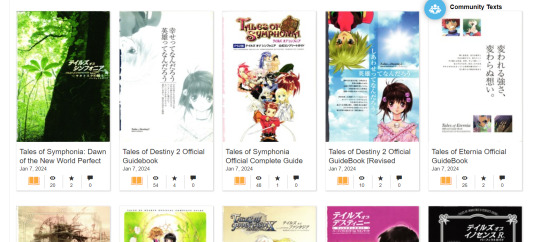
a generous fan who'd prefer to remain anonymous has been uploading complete scans of guides/perfect guide books from across the series, including most mothership titles and even a few spinoffs!!
I can't read a lick of Japanese myself but I've been having fun putting the Graces perfect guide through Google Translate's OCR anyway, would highly recommend to any fan 👍
#tales series#tales of#official#tales of symphonia#tales of the abyss#tales of xillia#at the moment vesperia zesty berseria and arise are missing as mainline games#but given how the most recent upload was jan 25th they're probably still going#and either way this is a great resource for the series as a whole
285 notes
·
View notes
Text
Hi everyone —
I just recently came across a real life copy of The Secret of Sherlock Holmes script book, so I scanned it for us. [scan]
I have a whole post about the play [here] with lots of links: to the audio bootlegs, the script, the program, the wonder that is Jeremy Brett and Edward Hardwicke and Jeremy Paul, etc. and I added this scan to that post too. I know someone already transcribed the script book and posted it and I linked to that one too, but I had it in my hands and I couldn’t not scan it for all of us. I ran the OCR text recognition for screen reading capabilities and it made the title page just a bit wonky but other than that it looks good. Also the cover is bright orange lol.
Enjoy!

#sherlock holmes#granada holmes#jeremy brett#edward hardwicke#jeremy paul#the secret of sherlock holmes#sh books
393 notes
·
View notes
Note
May I ask what scanners / equipment / software you're using in the utena art book project? I'm an artist and half the reason I rarely do traditional art is because I'm never happy with the artwork after it's scanned in. But the level of detail even in the blacks of Utena's uniform were all captured so beautifully! And even the very light colors are showing up so well! I'd love to know how you manage!
You know what's really fun? This used to be something you put in your site information section, the software and tools used! Not something that's as normal anymore, but let's give it a go, sorry it's long because I don't know what's new information and what's not! Herein: VANNA'S 'THIS IS AS SPECIFIC AS MY BREAK IS LONG' GUIDE/AIMLESS UNEDITED RAMBLE ABOUT SCANNING IMAGES
Scanning: Modern scanners, by and large, are shit for this. The audience for scanning has narrowed to business and work from home applications that favor text OCR, speed, and efficiency over archiving and scanning of photos and other such visual media. It makes sense--there was a time when scanning your family photographs and such was a popular expected use of a scanner, but these days, the presumption is anything like that is already digital--what would you need the scanner to do that for? The scanner I used for this project is the same one I have been using for *checks notes* a decade now. I use an Epson Perfection V500. Because it is explicitly intended to be a photo scanner, it does threebthings that at this point, you will pay a niche user premium for in a scanner: extremely high DPI (dots per inch), extremely wide color range, and true lossless raws (BMP/TIFF.) I scan low quality print media at 600dpi, high quality print media at 1200 dpi, and this artbook I scanned at 2400 dpi. This is obscene and results in files that are entire GB in size, but for my purposes and my approach, the largest, clearest, rawest copy of whatever I'm scanning is my goal. I don't rely on the scanner to do any post-processing. (At these sizes, the post-processing capacity of the scanner is rendered moot, anyway.) I will replace this scanner when it breaks by buying another identical one if I can find it. I have dropped, disassembled to clean, and abused this thing for a decade and I can't believe it still tolerates my shit. The trade off? Only a couple of my computers will run the ancient capture software right. LMAO. I spent a good week investigating scanners because of the insane Newtype project on my backburner, and the quality available to me now in a scanner is so depleted without spending over a thousand on one, that I'd probably just spin up a computer with Windows 7 on it just to use this one. That's how much of a difference the decade has made in what scanners do and why. (Enshittification attacks! Yes, there are multiple consumer computer products that have actually declined in quality over the last decade.)
Post-processing: Photoshop. Sorry. I have been using Photoshop for literally decades now, it's the demon I know. While CSP is absolutely probably the better piece of software for most uses (art,) Photoshop is...well it's in the name. In all likelihood though, CSP can do all these things, and is a better product to give money to. I just don't know how. NOTENOTENOTE: Anywhere I discuss descreening and print moire I am specifically talking about how to clean up *printed media.* If you are scanning your own painting, this will not be a problem, but everything else about this advice will stand! The first thing you do with a 2400 dpi scan of Utena and Anthy hugging? Well, you open it in Photoshop, which you may or may not have paid for. Then you use a third party developer's plug-in to Descreen the image. I use Sattva. Now this may or may not be what you want in archiving!!! If fidelity to the original scan is the point, you may pass on this part--you are trying to preserve the print screen, moire, half-tones, and other ways print media tricks the eye. If you're me, this tool helps translate the raw scan of the printed dots on the page into the smooth color image you see in person. From there, the vast majority of your efforts will boil down to the following Photoshop tools: Levels/Curves, Color Balance, and Selective Color. Dust and Scratches, Median, Blur, and Remove Noise will also be close friends of the printed page to digital format archiver. Once you're happy with the broad strokes, you can start cropping and sizing it down to something reasonable. If you are dealing with lots of images with the same needs, like when I've scanned doujinshi pages, you can often streamline a lot of this using Photoshop Actions.
My blacks and whites are coming out so vivid this time because I do all color post-processing in Photoshop after the fact, after a descreen tool has been used to translate the dot matrix colors to solids they're intended to portray--in my experience trying to color correct for dark and light colors is a hot mess until that process is done, because Photoshop sees the full range of the dots on the image and the colors they comprise, instead of actually blending them into their intended shades. I don't correct the levels until I've descreened to some extent.
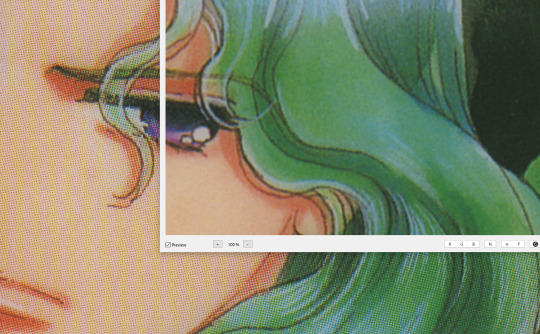
As you can see, the print pattern contains the information of the original painting, but if you try to correct the blacks and whites, you'll get a janky mess. *Then* you change the Levels:
If you've ever edited audio, then dealing with photo Levels and Curves will be familiar to you! A well cut and cleaned piece of audio will not cut off the highs and lows, but also will make sure it uses the full range available to it. Modern scanners are trying to do this all for you, so they blow out the colors and increase the brightness and contrast significantly, because solid blacks and solid whites are often the entire thing you're aiming for--document scanning, basically. This is like when audio is made so loud details at the high and low get cut off. Boo.
What I get instead is as much detail as possible, but also at a volume that needs correcting:
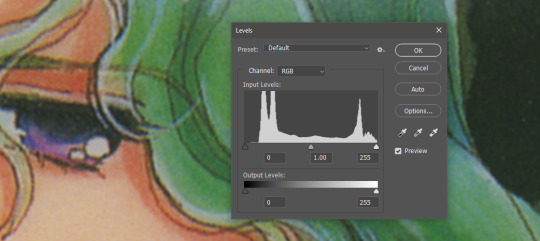
Cutting off the unused color ranges (in this case it's all dark), you get the best chance of capturing the original black and white range:
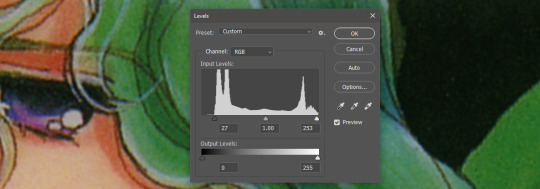
In some cases, I edit beyond this--for doujinshi scans, I aim for solid blacks and whites, because I need the file sizes to be normal and can't spend gigs of space on dust. For accuracy though, this is where I'd generally stop.
For scanning artwork, the major factor here that may be fucking up your game? Yep. The scanner. Modern scanners are like cheap microphones that blow out the audio, when what you want is the ancient microphone that captures your cat farting in the next room over. While you can compensate A LOT in Photoshop and bring out blacks and whites that scanners fuck up, at the end of the day, what's probably stopping you up is that you want to use your scanner for something scanners are no longer designed to do well. If you aren't crazy like me and likely to get a vintage scanner for this purpose, keep in mind that what you are looking for is specifically *a photo scanner.* These are the ones designed to capture the most range, and at the highest DPI. It will be a flatbed. Don't waste your time with anything else.
Hot tip: if you aren't scanning often, look into your local library or photo processing store. They will have access to modern scanners that specialize in the same priorities I've listed here, and many will scan to your specifications (high dpi, lossless.)
Ahem. I hope that helps, and or was interesting to someone!!!
#utena#image archiving#scanning#archiving#revolutionary girl utena#digitizing#photo scanner#art scanning
242 notes
·
View notes
Text
conceded to my destroyed sleep schedule and decided to pop open some ebooks & see if I could make sense of some "canon" nomenclature madness. And... hm. results odd. *
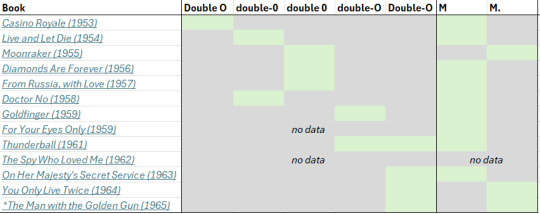
So. While I thought perhaps Double O was the standard. Turns out Mr Fleming only used it the once, in Casino Royale. Thanks, Mr Fleming.
And then there's a slow drift and he seemed to settle on Double-O/double-O by the end(capitalization could pooossibly be one of those things "silently corrected" by ebook creators? and/or different publisher editors?). If we're going case sensitive, then "Double-O" wins by a technicality and a very thin margin in terms of frequency of use.
also funnily enough, lol. M mostly appears as "M" no period. But will sometimes appear as "M." with period. which is incredibly distracting and I think we should agree that none of us should do this ever.
Wikipedia makes the bold choice of listing their page under "00 Agents," and spells it out on that page as "Double O." The wiki page for James Bond carefully avoids spelling it out, lmao, except for where it quotes Goldfinger, so it appears as "double-O" (which they also use for their 'pronounced as' parenthetical).
Honestly. I dunno. Double-O. Double O. double no longer looks like a word so I have no clue where my opinion/preference lies on this now, lmao. I think either would be fine with a screen reader, so I don't care on that front. Maybe Double-O IS the way to go, despite being more annoying to type? Double O Section. Double-O Section. hm. maybe the latter, aesthetically? very annoying to type tho. (I will probs still continue to use 00 for posts tho lol. cuz. easier to type! lol)
--
*caveat that yea assuming the project gutenberg ca/fadedpages ebook versions I'm seeing are "true" versions of the orig - and also who knows if different publishers in different countries made editorial changes too, possibly, so maybe possibly there are even different versions across the same book in different publishers/runs. fadedpages/pgdcanada notes they made changes for formatting but not for spelling etc, but gutenberg ca, while additionally listing the edition the ebook is based on (which fadedpages doesn't seem to obviously do?) does also note that "obvious" typos have been silently corrected. Thunderball across different sources did actually list it differently - double-O in the pretitle page seems to always be the case, but sometimes the text has an uncapitalized one while the rest are Double-O. there's an archive.org transcript ver that has it as Double-0, but I believe this was faulty OCR from a pdf scan since it clearly had the more rounded O but came up as 0 in ocr.
15 notes
·
View notes
Text
Dear Brother (Oniisama e…) LaserDisc scans and machine translations

These past few years I have fallen in love with the work of director Osamu Dezaki. Alongside Tomorrow’s Joe (Ashita no Joe), I hold Dear Brother in the highest regard.
It was a 1991 anime based on Riyoko Ikeda’s 1974 manga. You should watch the anime. It’s on Tubi for free. But really, just trust me. Buy the Blu-Ray from Discotek.

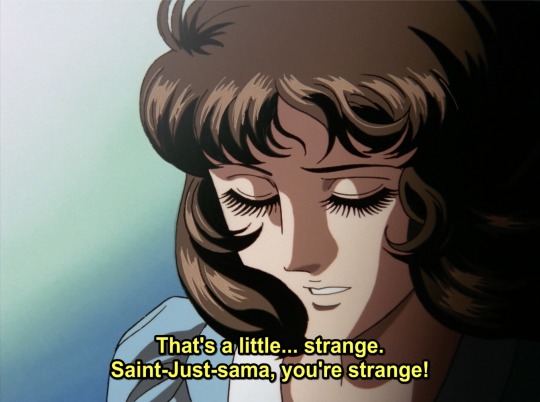
This anime came and went. There isn’t any merchandise besides some phone cards. Decaying fan sites and discourse is out there, but it’s a bit of a hunt.
Some time ago I saw a fan letter written by Hideaki Anno, apparently from the LaserDisc releases. From what I could tell, the LaserDisc packaging featured a treasure trove of notes from the staff that I just had to read. But I couldn’t find them!
If you’re not aware, LaserDiscs are one step above burnable trash in Japan — often on sale for 200 yen or less in heavy boxes shoved into the corner of second-hand anime stores. So I bought all five volumes of the 1993 Dear Brother LaserDisc release, was thrilled to notice unique letters from staff and industry luminaries in the interiors, and I scanned everything! And machine translated them.
I hope this (long, comprehensive) post brings fans of Dear Brother the same pleasure it brought me to compose it!
Note: I cannot read Japanese. I’ve used Google Lens for OCR, and GPT-4 for translation. My scans are good (and you can get them on Archive.org in high res) but these translations are not archive-quality and should not be depended on without verification. I’ve done my best to make corrections and have attempted to wrangle the correct tone and meaning out of the AI, but they’re essentially just for fun. Corrections of the most egregious stuff would be welcomed, email me: [email protected].
Volume One

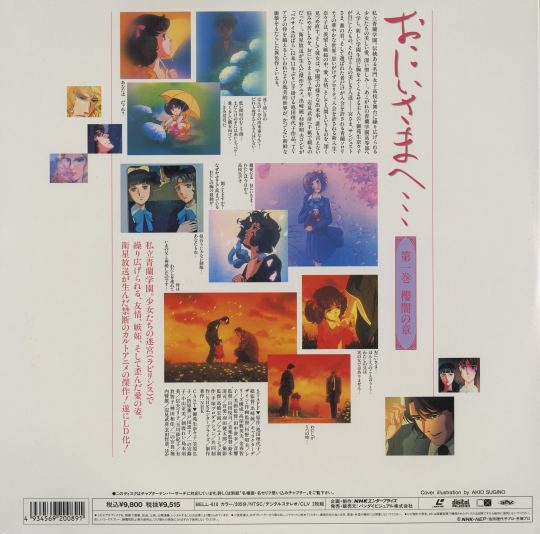
Each disc is themed after a character and colour. The back is peppered with screencaps and notable quotes (“Anata wa dare?” says little Nanako) as well as series credits. The two notable parts to translate are the disc synopsis, and the subheading (seen here in pink on the far left.) Maybe it’s a pull quote? Not really. So I called it a subheading.
Volume One Subheading
A forbidden cult anime masterpiece born of satellite broadcasting is finally available on LD.
Volume One Synopsis
Private Seiran Academy. A story of beautiful love and deep hatred unfolds at this prestigious all-girls high school steeped in tradition. The protagonist, Nanako Misonoo, who is thrilled to enroll in the high school division of her dream academy, encounters three stunning individuals: Miya-sama, Sanjust-sama, and Sho no Kimi. She also gets introduced to the glamorous world of Seiran Sorority, a society that only the chosen few are allowed to join. As a freshman granted unexpected membership in the Sorority, Nanako begins to take a deep look at love, friendship, and the essence of being human, all while being surrounded by envy and jealousy. She confides her various experiences at the academy, along with unspeakable worries and hardships, in letters to her elder “brother” and a young man named Takehiko Henmi… A masterpiece anime born of satellite broadcasting. It is a work by Riyoko Ikeda that the Dezaki-Sugino duo took on for the first time in 11 years since “The Rose of Versailles.” It is considered a unique work that brings a fresh, unprecedented shock by transcending the framework of TV anime with its aesthetic world.
The disc looks like this:
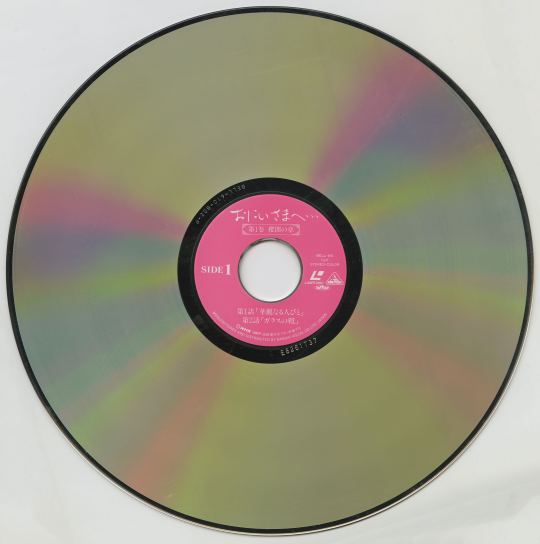
An “obi” (sash that covers the spine) is included. Of course, it says “My tears won’t stop!” in huge text, sells it as the latest Dezaki/Sugino collaboration, and describes it as tanibi na sekai — a poetic concept of a romantic, sublime world of aesthetic beauty.
There are two paper inserts in each volume. The first one looks like this, and is an index of LaserDisc chapter markers based not on plot developments, but notable character quotes.
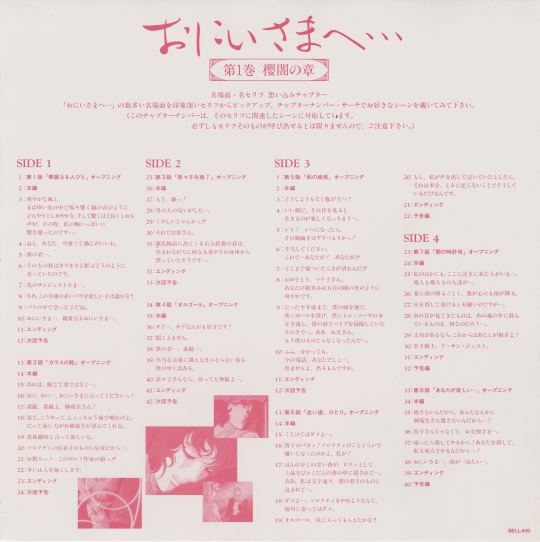
There’s also a form you can fill out to get a telephone card. Simply cut out a coupon from each volume to prove you bought the full set. Be quick, entries are due end of March 1994.
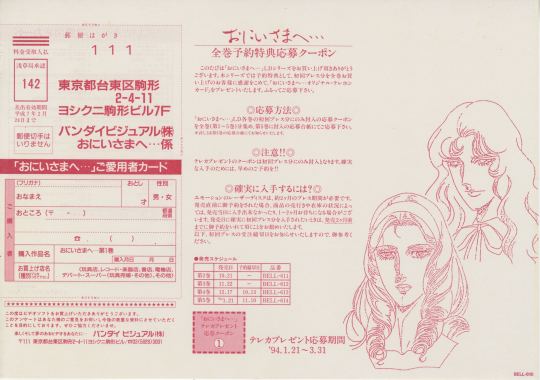
The interior is the best part. Here’s the spread for Volume One.
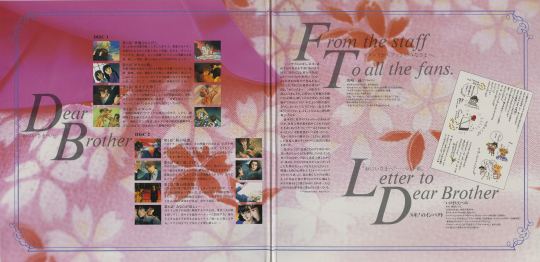
I haven’t translated episode synopses, but I’ve attempted to translate both the staff letter and the “letter to dear brother” from someone external to the production. There’s a bio for each author.
Volume One’s “From the staff to all the fans”
Bio:
Osamu Dezaki Joined Mushi Production in 1963. After directing series like “Astro Boy” and “Goku’s Great Adventure,” he was selected as the general director for “Tomorrow’s Joe” in 1970 at the young age of 26. Born on November 18, 1943, and hailing from Tokyo, he has received high praise as a director. Subsequently, he has brought numerous masterpieces into the world, including “Aim for the Ace!”, “The Adventures of Ganba,” “Nobody’s Boy,” “Treasure Island,” “The Rose of Versailles,” “Space Adventure Cobra,” “BB,” and more. He is also referred to as “Sakimakura” and “Mataba Sakimakura.”
The letter:
This is my second time working on Ikeda-san’s work since “The Rose of Versailles.” Her works have a unique aroma, whether you call it a theme or a world. They seem to pursue the literary aspect of the story. When I read the original work of “Dear Brother,” I was very drawn to these aspects, and at the same time, I felt a sense of anticipation that it would be difficult, but perhaps various images could be created. It’s not just about being cool or intense; it’s about creating images that resonate more and more with people’s hearts. Fundamentally, there is an original story, but when the characters start to move, and each begins to live, the story could go anywhere. I always had that sense of tension. So, rather than sticking to the original work, I placed more emphasis on the directorial focus of the reality of the characters who had started to move. As for the techniques, it was not something I was particularly conscious of, but I used a lot of completely black shots simply because I honestly felt they needed to be black. Whether or not it was successful, I wanted to effectively overlap the visuals with the characters’ psychology by delivering such physiological shocks. The psychological fluctuations of the people are indeed the overall aroma of this work. How the audience perceives that aroma is something I want to leave up to each individual’s free sensitivity. - July 8, 1993, at Tezuka Pro
Volume One’s “Letter to Dear Brother”
Bio:
Mutsumi Inomata Born on December 23 in Kanagawa Prefecture. After working with Ashi Production and Kaname Production, she is currently freelance. After going through Ashi Production and Kaname Production, she is now a freelance artist. Mutsumi Inomata is her real name. She was born on December 23 in Kanagawa Prefecture. She is active in both the fields of anime character design and illustration. In the realm of animation, she served as the character designer and chief animation director for works such as “Plawres Sanshiro” and “Genmu Senki Leda,” and as the character designer for “Future GPX Cyber Formula.” As an illustrator, she has also provided numerous illustrations for novels, including titles like “Prince of the Universe,” “Dragon Quest,” and “Continent of the Wind.”
The letter:

Comics are way hard to translate without actually knowing Japanese. Here’s my best effort to uncover some meaning.
For several years, I had stopped watching anime and stuff… Living a hectic life, it’s been like this for a while now. Having a set day and a set time to watch a specific program (not just limited to anime), had become impossible for me. Recording videos is also a hassle, and first and foremost, I just don’t feel that “I must watch the next episode!” kind of emotion anymore. Ah well, I was thinking maybe I’ve just become an adult. Heh heh heh. I’m such an idiot. No, that’s not it.
The blonde guy in the bottom-right is labeled as her friend, and she’s saying something about “Poupee-chan”. I think in the second panel he’s yelling saying “But that doll is supposed to be a girl!”
The final monologue starts with:
By the way, I have a container for “dangerous items” at the corner of my work desk. I keep things like cutter blades in it, so that I don’t accidentally drop them on the floor and cut myself or something. The “dangerous items” container I’m using now has a sticker with Saint-Just-sama’s “Nanako’s Eyes,” heh heh heh ♡
That’s about all there is to note about Volume One, besides the fact it comes with an enormous poster (it’s the same art used on the cover of the Discotek Blu-Ray.)
Volume Two


Volume Two Subheading
Those eyes of that person, mysteriously and beautifully shining. Why these feelings? Why...? The increasing heartbeat, the endless tears of adolescence. A masterpiece of forbidden cult anime born from satellite broadcasting! The second installment on LaserDisc!
Volume Two Synopsis
Nanako’s life at school, after being chosen as a sorority member, was not all glitz and glamour. There were misunderstandings with her best friend Tomiko, and jealousy and slander from other students, including Misaki Aya. And then there was the obsessive love from her fellow sorority member, Nobuo Mariko. “What is a sorority? Is it really that important?” Nanako began to question the very existence of sororities. Yet, she tries to look straight into herself, even while confused. Always before her were the mysteriously beautiful and shining eyes of Saint-Just. Drawn to those eyes that seemed to peer into a distant past, Nanako attempts to uncover their secret. Then, by chance, she finds out about the special relationship between Fukiko and Saint-Just. Could it be that Miya-sama and Saint-Just-sama are…? The complicated interplay of relationships and the previously enigmatic characters start to become a little clearer in “Volume 2: The Chapter of Freezing Rain.” The subtle breaths of the people surrounding Nanako can be heard.

Volume Two’s “From the staff, Dear Nanako”
Bio:
Hideo Takayashiki Born in 1947, native of Iwate Prefecture. After passing through Osamu Tezuka’s Mushi Production, became a scenario writer. Known for scripts of theatrical anime films such as “Hang in There, Tabuchi-kun!”, “Barefoot Gen”, and the “Phoenix” series. Also worked on numerous TV anime scripts like “Gutsy Frog”, “Gamba’s Adventure”, and “Tomorrow’s Joe”. Additionally, wrote scripts for original videos and TV dramas like “The Laughing Target”, “One-Pound Gospel”, and has written many novels, actively contributing as a versatile scriptwriter. Member of the Japan Broadcast Writers Association.
The letter:
Dear Nanako Misonoo, How are you? How is university life? It’s hard to believe that three years have passed since then. I was involved with you and those around you for just one year, but in retrospect, it was a very intense year. In any case, I did something terrible to you. It may have been the extreme form of “bullying” in some sense. My work as a scriptwriter involved probing and expanding the uncharted worlds between the frames of original works, constructing new narratives. In a sense, it was a painful job. And for you, it was excruciating. But now it’s a wonderful memory. I am filled with the feeling that I did some real work after a long time. How is your best friend, Tomoko? What about Mariko? I assume Fuki is becoming more and more beautiful? Do you occasionally receive letters from Kaoru? This summer marked the third anniversary of Saint-Just-sama’s passing. Thinking back, it was an unusually hot day. Your anguished form, waiting alone at the platform while listening to the chirping cicadas and the sound of the sea, is still etched in my memory. I hear that there has not been a single day without flowers at the electric pole where Saint-Just-sama fell. I am grateful for the chance to have met you and the people around you. Autumn, 1993
Volume Two’s “Letter to Dear Brother”
Bio:
Kazuhiko Shimamoto Born April 26, 1961 From the hinterland of Hokkaido After being selected as an honorable mention in the 9th Shogakukan Newcomer Comics Award Debuted with “Hissatsu no Transfer Student”. His masterpieces include Gyakkyo Nine’ and Moeyo Pen. Examples include Flame Transfer Student’ and Kamen Rider ZO.”
The letter:
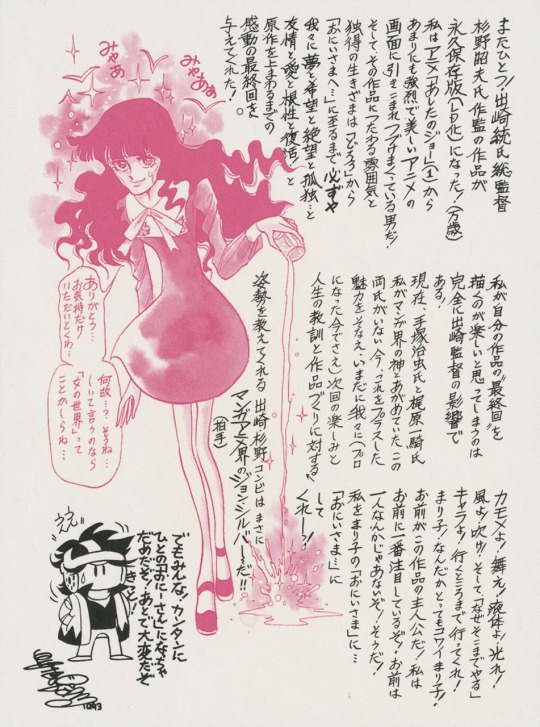
Another piece directed by Osamu Dezaki and supervised by Akio Sugino has become a permanent edition (converted to LaserDisc)! (Hooray!) From the anime “Ashita no Joe” (1), the unique and beautiful way of life portrayed in anime is so intense that it has consistently given us dreams, hopes, despair, loneliness, friendship, love, perseverance, and revival! These works have even surpassed the original works in the emotional impact of their final episodes. I continue to be captivated by the atmosphere conveyed by these works. The reason I enjoy drawing the final episodes of my own works is entirely due to Director Dezaki’s influence! Currently, Osamu Tezuka and Ikki Kajiwara, the two individuals whom I revered as gods in the manga world, are no longer with us. Even now, these works, which possess added charm, continue to provide us (even those who have become professionals) with anticipation for the next episode, life lessons, and motivation for creating works. Seagulls, dance! Liquids, shine!! Wind, blow and then, “Why go to such lengths?” Charafo! Go as far as you can go! Mariko, somehow you’re really scary, Mariko.
Then the words scribbled next to the drawing of Mariko:
You are the protagonist of this work! I’m paying the most attention to you. You’re not alone! That’s right! Make me Mariko’s ‘older brother’… ‘older brother’…
Mariko is saying (OCR mangling here, sadly):
Thank you… I just feel… that’s special… Why not? If I had to say, maybe it’s a ‘woman’s world’…
(Clearly a reference to Rikiishi Toru of Dezaki’s earlier anime Ashita no Joe, who intensely speaks of a “man’s world”. He and Mariko love a good starvation diet!)
The little chibi version of Shimamoto(?) in the bottom left is saying:
But everyone, don’t easily become someone’s ‘older brother.’ It’ll be troublesome later!
GPT-4 noticed a cute reference it couldn’t include in its translation. Its note:
The text seems to be OCR scanned partially, and hence some meanings might be missing or distorted, such as “マンガ界のジョン・シルバーだ!!”, which appears to compare Dezaki and Sugino to a ‘John Silver’ of the manga world.
Volume Three

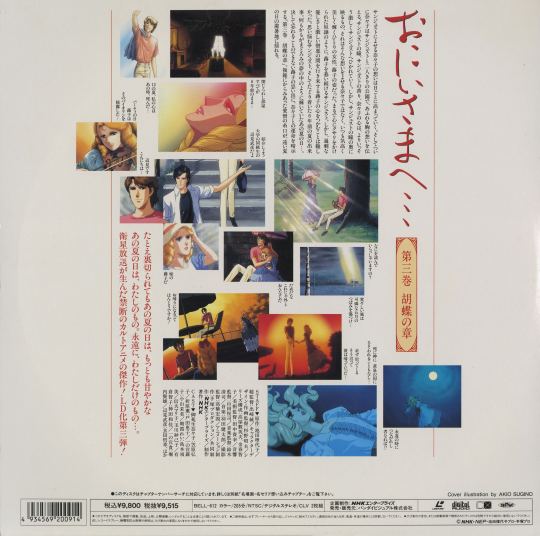
Volume Three Subheading
It’s not too late; our beautiful time can still be preserved, forever unspoiled, just like this white snow… A forbidden masterpiece of a cult anime born from satellite broadcasting! The fourth release on LD!
Volume Three Synopsis
Suddenly summoned to the sorority house, Nanako is pressured by Fukiko to end her relationship with Hemimi. Upon hearing this, Saint-Just confesses her complicated relationship with Fukiko. The shocking truth behind why “Miya-sama” wanted Nanako in the sorority unfolds, leaving her deeply shaken. Meanwhile, Saint-Just is tormented by the realization that the stronger her feelings for Fukiko, the more she ends up hurting her. The complex relationship between Saint-Just and Fukiko has a tragic past involving a near-suicidal event. On another front, Mariko causes an incident by attacking Misaki, motivated by slander about her parents’ divorce, which leads to a movement spearheaded by Kaoru to abolish the sorority. Amid the crumbling sorority, Fukiko remains composed. The fourth volume, “Chapter of Snow Dance,” captures her frightening yet noble confidence and deep sorrow. In the snow that never melts, remains the sad yet beautiful promise of Saint-Just.

Volume Three’s “From the staff to all the fans”
Bio:
Tomoko Konparu Born on March 13, 1956, in Nara Prefecture. Pisces. Blood type AB. A fan of both manga and anime, she became a screenplay writer and debuted during her university days with “Ikkyu-san.” Anime works include “Urusei Yatsura: Only You,” “Urusei Yatsura: Remember My Love,” “Touch 2: Farewell Gift,” “Phoenix,” “Cat’s Eye,” “Hime-chan’s Ribbon,” and more. Novel works include “Mystery at the Tower of London,” “Mystery at Nara’s Great Buddha” (published by Kobunsha Bunko), among others.
The letter:
When I heard that this work was going to be turned into an anime, I was shocked. I’d known about the series since its serialization, so my reaction was something like, “What!? Are they really going to do it!? And on NHK of all places!?” Expanding on the original work and filling in the parts that hadn’t been depicted was incredibly challenging, but also enjoyable. What surprised me was that, around the midpoint, the characters started to assert themselves, taking actions that were entirely different from what I had planned. The princess would say, “My pride isn’t so easily swayed,” San Just would insist, “I’m not going to commit suicide,” and even the older sisters of the sorority were like, “We can’t back down now.” Every time this happened, I had to rework the composition. This phenomenon of “characters moving on their own accord” was a first for me in an anime series, and it was an incredibly fresh and pleasant experience. That being said, it’s rare to be so emotionally invested in characters while working, to the point of even role-playing their lines. To be honest, this was a work that got my inner anime fan excited. Ah, I want to do work like this again!
Volume Three’s “Letter to Dear Brother”
Bio:
Keiko Fukuyama Born on September 7. From Tokyo. Currently, she is working as a manga artist, authoring works like “Ruru-chan of Star Island” and “The Tale of Appfelrant.” She also illustrates for children’s stories, including the “Mama Ghost Series.”
The letter:

It appears to be titled “To the Unforgettable Older Sister”. Much of it is too hard to OCR. It opens with this caption:
“To My Older Brother…” is so melancholic and sentimental that it instantly takes us back to our student days where we felt we were tossed around by fate for no fault of our own…
Here’s some of the text beside the character drawings:
Fukiko/Saint-Just: Reputed as the most beautiful sisters in school Mariko: The most popular Mariko-san who lured our tears. There’s a lot to think about! Tomoko: A straightforward, kind friend Nanako: So there I was, fully embracing my Nanako persona, reaping all the sorority perks you could imagine. (I mean, they even say they’ll hook me up with a dreamy guy!) 💧 And just when I’m soaking up that sorority vibe, guess who’s set to make a surprise appearance right after the teaser for the next issue!
Text coming out of the TV:
It was “Oniisama e”!!!! Poor Mariko-san, right~ Misaki-san also, there was no need to say that much, you know.
Volume Four

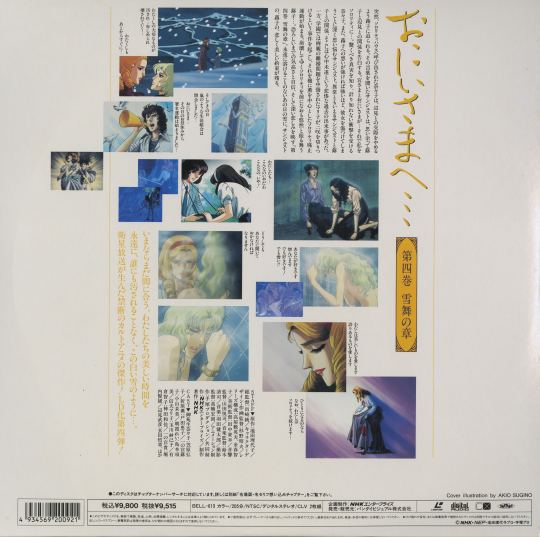
Volume Four Subheading
It’s not too late yet, our beautiful time can still last forever, unspoiled by anyone, just like this white snow… A forbidden cult anime masterpiece born from satellite broadcasting! The fourth installment on LD!
Volume Four Synopsis
Suddenly summoned to the sorority house, Nanako is pressured by Fukiko to end her relationship with Hemmi. Hearing this, Sanjust is compelled to confess his relationship with Fukiko. The shocking truth makes Nanako reel in disbelief. He deeply ponders that the stronger his feelings for Fukiko, the more he ends up hurting her. The unusual relationship between Sanjust and Fukiko reveals a tragic past of a failed double suicide. Meanwhile, in the school, an incident occurs where Mariko, slandered for her parents’ divorce, attacks Misaki, leading to an anti-sorority movement centered around Kaoru. Fukiko still acts nonchalantly in front of the crumbling sorority. The volume unfolds displaying Fukiko’s terrifying yet noble confidence and deep sorrow. A beautiful yet sad promise lingers in the snow that never melts.

Volume Four’s “From the staff to all the fans”
Bio:
Kenichiro Haneda Born on January 12, 1949. Graduated from Toho Gakuen College of Music in the Piano Department. An accomplished concert pianist, Kenichiro Haneda has a broad range of experience, including composing and performing music for movies and TV themes, as well as acting as a musical director for musicals and commercials. He has worked on numerous soundtracks such as NHK’s morning drama “Youth Family,” TBS’s “Women Work Hard” and “Life Is Full of Demons.” With his genre-defying approach to music and his bright, humorous personality, he is a sought-after multi-artist in various fields.
The letter:
I’ve worked quite a bit with Music Director Seiji Suzuki in the past. Suzuki gives me the music menu, and I’m the one who creates it. We’ve had some pretty detailed discussions about it. Of course, I’ve read the original work as well. When I read it at home, my daughter gives me a puzzled look, as if to say my interests have changed quite a bit (laughs). I think I wrote around 40 songs in total. The music is meant to have a Baroque sound while also feeling contemporary. The order was for something classical yet with a pop atmosphere. The image that immediately came to my mind was a rhythm section, with a harpsichord playing the melody. String instruments intricately marking the rhythm, much like Vivaldi’s Four Seasons. And on top of that, a flugelhorn playing the melody… Regarding the scenes where the piano is played, I played all of it myself. I often compose and perform my own pieces. It’s less about talent and more like playing two roles; maybe I contribute quite a bit to cost-saving (laughs). In any case, this work has a unique atmosphere. If the music I created successfully captures that, then I must again express my gratitude to Suzuki for coordinating everything. October 28, 1993, aired on NHK
Volume Four’s “Letter to Dear Brother”
Bio:
Hideaki Anno Born on May 22, 1960. Originally from Ube, Yamaguchi Prefecture. Height is 180 cm; weight is a secret. Debuted as an animator during his time at Osaka University of Arts, working on the TV version of “Macross.” Later worked on “Nausicaä of the Valley of the Wind,” the film version of “Macross,” “Royal Space Force,” and others, before directing “Gunbuster” and “Nadia: The Secret of Blue Water.” Currently planning new projects.
The letter:

Way to go!! Oniisama e… Wow!! The long-awaited, tumultuous Volume 4!! This volume shows us the peak of the series, from Mariko-san’s stabbing incident to the dissolution of the sorority. Amazing, this is really amazing!! Yes. Especially the heartbreaking breakdown of Nobuo’s family, and the portrayal of the sorority’s downfall reminiscent of the French Revolution, are things that are indescribable with words. Yes. The highlights this time are– Brilliant! Highly sophisticated direction and high-quality animation in Episode 27! Tear-jerking! In Episode 28, Mr. Nobuo Hikawa’s soul-stirring outcry!! Upon hearing those lines, my tears really wouldn’t stop. Seriously. Amazing!! Oh, so moving! The heartfelt words of Miya-sama at the end of Episode 32. The sight of Miya-sama waiting alone in the Sorority House and those lines really hit me hard. Moreover, as always– Incredible!! The world that reminds me of ‘Aim for the Ace!’ and ‘The Rose of Versailles’!! Impressive!! The drama unfolds only in limited settings, like homes, trains, buses, crossings, schools, and other familiar places!! Very Sophisticated!! The direction, composed of stillness and motion, light and black, feels so mature. As expected, Dezaki-san! And, Powerful!! Nanako-san is turning into an adult right before our eyes. Moreover, the music is also great!! I wish the BGM CD would come out soon. The use of chimes and telephones remains clever as ever!! Ah, the only thing missing is a bit more on the background elements… by H. ANO ‘93 10/27
The tiger is saying “It’s awesome, isn’t it!”
Written above the drawings of Mariko and Saint-Just: “These two are definitely the ones. Yes.”
Volume Five
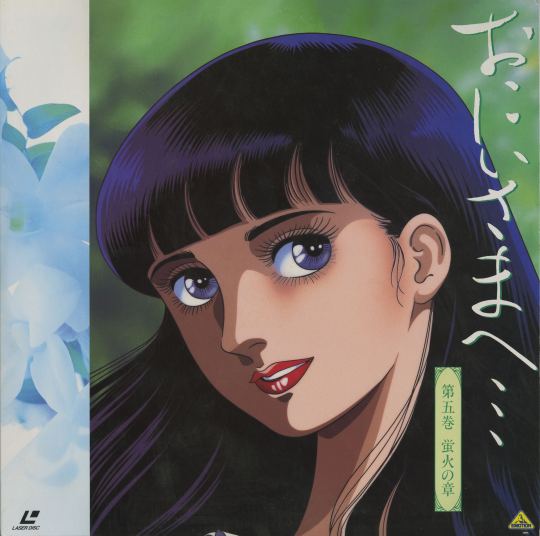
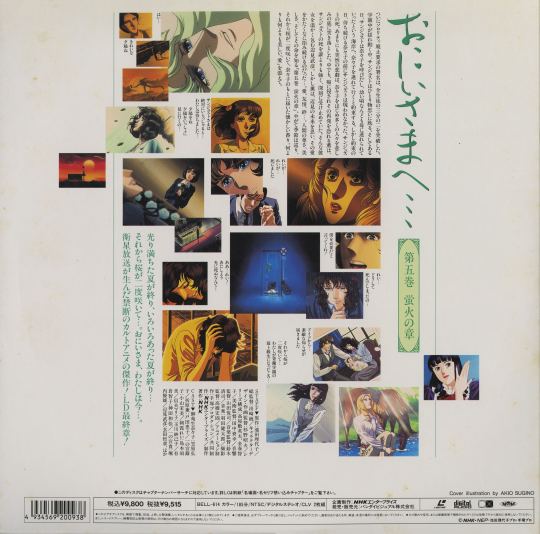
Volume Five Subheading
The summer full of light ends, the eventful summer ends… And then the cherry blossoms bloom again… Brother, I am now… A satellite broadcast-born forbidden cult anime masterpiece! The final chapter on LD!
Volume Five Synopsis
Finally, the petition to abolish the sorority has garnered signatures from over two-thirds of all students. As the campus is in a state of upheaval, Saint-Just is lost in thought alone. One day, he calls Nanako out and promises to take her to the beach where he used to go often with his mother when he was younger. However, on the promised day, Saint-Just never shows up. His sudden death plunges many people, including Nanako, into the depths of sorrow. Among them, Kaoru, who is battling cancer and fearful of its recurrence, takes the news of Saint-Just’s death most seriously. She finds comfort in the warmth of Takahiko Henmi, but continues to stubbornly refuse his love, thinking about his future. Love, friendship, bonds… The fifth volume, titled “Chapter of the Fireflies,” explores the dignity, beauty, and value of human life. Seasons turn, and the cherry blossoms bloom again, bringing back familiar scents to Nanako. All of this is accompanied by the most beautiful “love.”

Volume Five’s “From the staff to all the fans”
Bio:
Riyoko Ikeda Born December 18, Showa 22 (1947). Native of Osaka City. Blood type AB. Graduated from Tokyo Metropolitan Hakutsuru High School and went on to the Philosophy department at Tokyo University of Education (now Tsukuba University). Began drawing manga during her time in school and debuted with “The Girl in the Rose Mansion.” In 1972, she achieved great success with “The Rose of Versailles,” acquiring a broad fan base that transcended the realm of girls’ manga. Known for her keen historical perspective and deep insight into human nature. Active as a writer and essayist as well. Her hobbies include Nihon buyo (Japanese traditional dance), oil painting, movie appreciation, vocal music, piano, cooking, and knitting. Her work has been selected for the 76th Nika Exhibition. Major works: “The Rose of Versailles,” “Window of Orpheus,” “Empress Catherine,” “To My Brother,” “At the Ends of the Sky,” “The Blue Pomegranate,” “My Manga” Books: “If Only Life Could Be Lived Once,” “Women of the French Revolution,” “Women Who Wrote Masterpieces” Currently writing “Eroica” and “Prince Shotoku.”
The letter:
As one who has journeyed far from that radiant chapter called youth, a time that shone with an almost awkward brilliance, I find myself in a peculiar blend of bewilderment and nostalgia. Seeing my old ideas of high school life come to life as animation almost 20 years later is surreal, to say the least. Still, it’s exciting: hearing voices given to these characters, seeing them talk, laugh, and get angry. Watching them come alive is truly a thrilling and satisfying experience. Ah, adolescence — everyone’s inescapable stairway to adulthood. Some people take each step slowly and carefully, while others rush ahead, ending up out of breath or even lost. And then, there are those who may lose their direction, standing still, contemplating each step. Wrapped in the love of family, meeting various people, nurturing friendships, experiencing love, and going through the ups and downs of hurt and forgiveness — it would be wonderful to climb those steps in such a way.
Volume Five’s “Letter to Dear Brother”
Bio:
Rumiko Takahashi Born in Niigata Prefecture. Debuted in 1978 with “Katte na Yatsura,” submitted while still in college, in Shonen Sunday. Famous works include “Urusei Yatsura,” “Maison Ikkoku,” and others. Currently serializing “Ranma 1/2” in Shonen Sunday.
The letter:
A masterpiece infused with the creator’s soul. When I heard from the staff that “Oniisama e…” was getting the anime treatment on satellite TV, I was surprised. I’d delved into the original comic before and it’s quite an eccentric story. “How are they going to pull this off?” I thought. But learning that the script was in the capable hands of my acquaintance Tomoko Konparu, I was very excited. In fact, the anime that aired was genuinely captivating. The characters are so larger-than-life that they electrify the screen the moment they step into frame. It’s been a long time since an anime had that kind of presence. I believe the animation is done by the same people who worked on “Tomorrow’s Joe 2.” The scenes are so visceral that you can almost feel the punches land and see the fighters hit the mat. I kept asking myself, “Why isn”t a mouthpiece flying out?” (laughs) My favorite character in the work is Nobuo Mariko. The scenes where she bites her lip until it turns a flushed red, I find it really cute. But what blew me away was the show’s emotional intelligence. Just when the heroine seems on the brink of breaking, a lifeline is thrown her way. This nuanced touch prevents the darker, more harrowing elements from overwhelming the viewer. It’s as if you can feel the sincerity of the creator throughout the piece.
And that’s it. Again, check out the full scans on Archive.org, and remember to encourage all your friends to experience this beautiful anime!
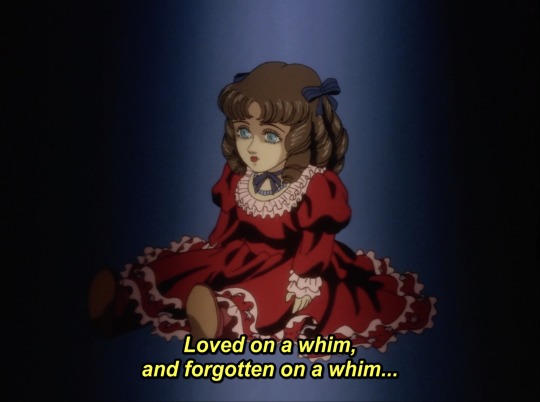
175 notes
·
View notes
Text
What the edition looks like on the page:

What the OCR sees:

This is, for the record, why even texts that have been scanned and OCRd are not necessarily searchable.
This particular one is driving me so nuts I am now just typing out the entire text so that I can have a reliably searchable version. The text is about 20k in total, so this is no small undertaking, but will probably save me a lot of grief in future and I should've done it four years ago when I started working on this story. Always the way.
#oidheadh con culainn#the absolute state of digitisation in medieval celtic studies i stg#finn is not doing a phd
21 notes
·
View notes